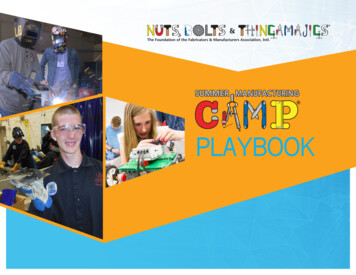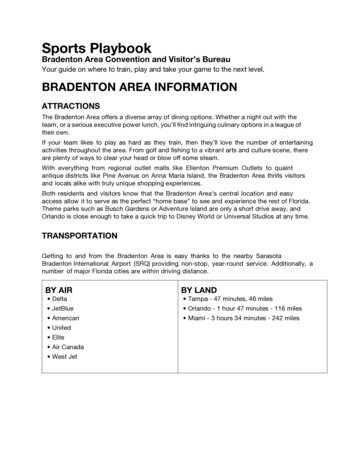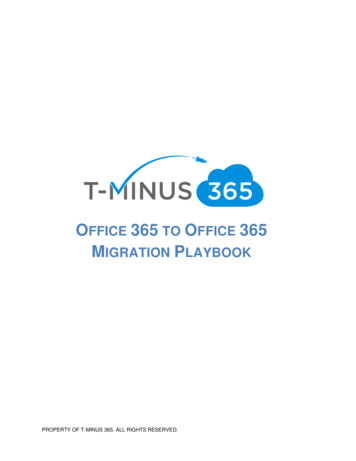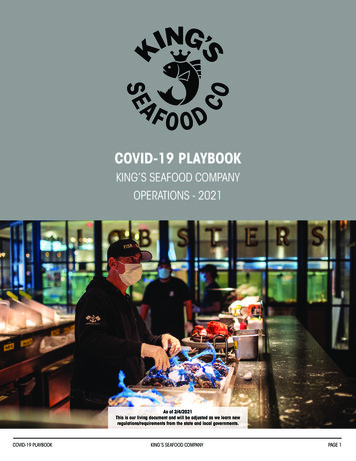
Transcription
PLAYBOOK
MISSIONTo engage, nurture, and exciteindividuals of all ages in the pursuitof careers in manufacturing.
CAMP DIRECTORPLAYBOOKCONTENTSSECTION 1:APPENDIX A:SECTION 2:APPENDIX B:SECTION 3:APPENDIX C:Getting Started – Engaging Community Manufacturers.4How to Apply for Your First Camp Grant.5Achieving Success with Your First Camp.6SECTION 4:Post-Camp Follow Up.12SECTION 5:Sustaining a Camp through the Grant Cycle and Beyond. 13Project Ideas, Plans, and Blueprints.14Tips on Hosting a Camp from a Seasoned Camp Director. 21Advice from a Manufacturer for Getting Supportfrom Your Local Manufacturing Community . 23
CAMP DIRECTORSECTION 1GETTINGSTARTEDPLAYBOOKEngaging the manufacturing community in your campsNuts, Bolts & Thingamajigs (NBT) campsare held at community or technical collegesand high schools with manufacturingtechnology programs. Typically, thefaculty members serve as instructors.A summer camp aimed at introducingstudents, ages 12-16, to the exciting worldof manufacturing through hands-ondiscovery will encourage more of them topursue a manufacturing career and gainthe necessary technical skills through thehost school’s programs. Many school’sadministrators comment that the campsserve to attract future students to theirmanufacturing programs. But camps can’tachieve their long-term goals in isolationfrom their area’s manufacturing businesses.Ultimately, the beneficiaries of a summermanufacturing camp program are thebusiness owners and companies in that4local community. Manufacturing campsare inspiring their future workforce!Consider which manufacturers in your areaare large employers, have a positive impacton the local economy, and are well-knownfor supporting community organizations.Consult individuals on your school’sadvisory boards and manufacturingprogram committees for recommendationsand ideas.When applying for a camp grant, a schoolshould propose at least two communitypartners and/or local manufacturers whowill agree to provide a plant tour or senda guest speaker or mentor to your camp.The tours and speakers should serve toexpose students to the local manufacturingindustry and highlight career opportunities.Other things that local businesses haveprovided to NBT camps are: Materials needed for projects builtin camps Bus rental costs for students traveling toa plant tour Lunch for students on plant tour days Funds for project supplies and tools Shop time for hands-on projectsApproaching the local companies withyour request for assistance may seem a bitdaunting. But these business people knowthat having a strong, motivated pipeline ofpotential employees is critical to keepingtheir businesses vibrant and growing.Getting them to help with your campproject may be easier than you think.nbtfoundation.org
CAMP DIRECTORSECTION 2APPLYINGFOR YOURFIRST CAMPGRANTPLAYBOOKHow to create a winning grant applicationVisit nbtfoundation.org/host-a-campFirst: Determine Eligibility Schools must have a degree programor curriculum leading to a career inmanufacturing and can offer courseworkfocused on business entrepreneurship.Next: Review the NBT Camp HostHandbook and the Grant Awards &Requirements flyer before you start yourapplication S chools must propose at least twocommunity partners and/or localmanufacturers to provide tours and/orguest speakers that can expose studentsto the local manufacturing industry andcareer opportunities. S chools must be able to accommodatea minimum of 12 participants per camp.Consider computer classroom size as wellas shop lab space availability. S chools must be able to provide a handsWe highly recommend that the peopleon manufacturing project experiencewho will be involved in administering,that covers design and build at least onepromoting, and teaching the camp meet inproject that each student can make andadvance of filling out the online application take home at the end of camp.to share ideas and plans. They should all C amp hours: minimum of 25 hours for ahave an opportunity to review the Campone-weekcamp and 45 hours for a twoHost Handbook and the Grant Awards &week camp.Requirements flyer.5 NBT recommends that camps chargeparticipants a minimum fee of 59 for aone-week camp or 99 for a twoweek camp. Exceptions or variations from any of thelisted requirements should be explained inyour application.Next: Preview the camp applicationWhile the application needs to besubmitted online, you can print a copyand make sure you have answers to allthe questions before you begin the onlineprocess.Finally: Submit a completed applicationonline July 1-December 1 for the nextsummer.nbtfoundation.org
CAMP DIRECTORSECTION 3ACHIEVINGSUCCESSWITH YOURCAMPPLAYBOOKImportant considerationsBe sure to give close attention to this list ofimportant considerations to ensure yourcamp is successful for your school, yourcamp participants, and your communityand manufacturing supporters:A. Promotion and marketingB. Coordination with NBTC. Tuition and camp scholarshipsD. Guest speakers and instructorsE. Hands-on engagementF. Impress the familiesG. DemographicsH. Local business support6A. Promotion and marketingabout your manufacturing camp. Many colleges have their summer Engage your college’s PR departmentprogram catalog in print by the endto write and distribute news releases onof January. If that is the case at youryour camp. Use the angle of the skilledcollege, don’t miss your biggest (free)labor crisis in manufacturing and howpromotional opportunity — be sure tothis camp will help to overcome the issueget your camp information to the onin your community. Plus, share all thecampus office that produces the cataloggreat photo opportunities that the socialin time. Be prepared by having your campmedia and PR team will have once thename, dates, and contact/registrationcamp is underway. Guaranteed successinformation available when you are fillingwith the media!out your grant application or Make sure that your communityshortly thereafter.partners can and are encouraged to NBT provides you with custom-designedpromote the camp to their employees.materials you can use to promoteGive them some of your custom postersyour camp to local schools or youthand flyers. Think about employees’organizations. Think about the schools orkids and grandkids who may be primeother community programs where youcandidates for your camp.may want to provide flyers or postersnbtfoundation.org
CAMP DIRECTORSECTION 3ACHIEVINGSUCCESSWITH YOURCAMPPLAYBOOKB. Coordination with NBTWe really want to help you host a greatcamp and will do our best to get you theinformation and materials you need on atimely basis. Please meet our requesteddeadlines before, during, and after yourcamp. Contact NBT Staff with anyquestions at 888-394-4362 orfoundation@fmanet.org.C. Tuition and camp scholarshipsOften, camp directors state that theycan’t charge a tuition because they servea population that would be priced outof the program if they did. Other times,the recommended NBT tuition of 59/week is not equivalent to prices for similarprograms focused on the samepotential audience.If your school serves an underprivilegeddistrict where families may not be able toafford the tuition, a good solution is to offercamp scholarships. You can set some typeof requirement or application for earninga scholarship. It may relate to having ateacher from their school recommendthem, or it may be that the student submitsan essay explaining why they want toattend. We have seen scholarship programstake many forms, but the important thing isthat parents and students see the programas a valuable use of their time and effort.Some colleges offer a wealth of summerprograms for kids and have establishedone standard price for all programs sothat camp participants don’t make theirregistration decision solely because ofprice. If all one-week camps at your schoolcharge 35 tuition, your manufacturingcamp also needs to charge 35, simplyAsking for a financial commitment from astate that in your application. We have seenfamily is one way to show that the programsuccessful camps that have charged as littlehas value and once parents have made aas 25 and as much as 395 for a one-weekfinancial commitment, they are more likelycamp. It has everything to do with whatto make sure that their student participates.works best in your community.7D. Guest speakers and instructorsLook for companies that offer variety inthe products they make, the technologiesthey feature, and the career paths theyoffer. It’s good to have enough potentialpartners available so that you can weatherany possible last-minute cancellations androtate your tours and presenters overthe years.One other important consideration is toseek variety in the people who interactwith your campers, whether they arepresenters or tour guides. Make sure theysee both men and women working inmanufacturing, including minorities, andas much as possible see folks from differentage groups. It’s fabulous when they caninteract with people who are young —both in years and in their careers — andpassionate about manufacturing.nbtfoundation.org
CAMP DIRECTORSECTION 3ACHIEVINGSUCCESSWITH YOURCAMPPLAYBOOKE. Hands-on engagementTours of manufacturing companies areterrific; in fact, they are the lifeblood of theNBT camp program. Making it possible forkids to get hands-on learning experienceis very important and we recommendthat you find ways to increase this touchand-feel aspect of their encounters atmanufacturing companies. Can your tourguide arrange for a table of samples thatwill make it possible for the kids to holdproducts or sample models in their hands?Please ask your tour guide to give the kidsa chance to get up-close-and-personal withthe company’s products. That’s a memorythey will never forget and will share withfamily and friends.When you are planning your camp’sdesign and manufacture project, makesure that it is something each student cantake home. We’ve seen some great campswhere the students make a team project,which is a great experience for teaching8team work and it’s also important thatevery camper go home with one itemthey’ve made themselves. The hands-onnature of these camps is what sets themapart from a regular day in school and canprovide inspiration to a child that doesn’tnecessarily excel in a typicalclassroom setting.F. Impress the familiesCamp graduation events are becomingmore and more common. Camp directorshave recognized that creating events onthe final day of camp, to which parentsand other family members are invited, arecrucial to the camp’s success. They allowfamily members to share in the experiencethe child has had. In most cases the kidsare involved in presenting or competing,and parents are amazed to see how muchtheir child has learned and accomplishedin a week or two. Frequently, parents gohome and talk up the experiences to theirfriends and other parents, guaranteeing anincrease in enrollment for the next year’scamp! See the following examples.At the GADgET Camp (Girls Adventuringin Design, Engineering, and Technology),held each year at Triton College, thegirls create and prototype a product. Ongraduation day, they demonstrate theirfinished products with a PowerPointpresentation for the entire audienceoutlining the reason for the product, thechallenges they faced in designing it, andhow they overcame those challenges.nbtfoundation.org
CAMP DIRECTORSECTION 3ACHIEVINGSUCCESSWITH YOURCAMPPLAYBOOKAt the Power of Manufacturing Camp,held each year at Fox Valley TechnicalCollege, the students design and buildpower tool race cars. On graduation daythey hold a drag race competition andfamily members and representatives fromlocal sponsoring companies are invited. Theaudience gets to witness just how adeptthe students have become at solving thekinds of technical problems that can occurin a high-pressure race environmentAt the Peninsula K-Next! Camp, heldeach year at Thomas Nelson CommunityCollege, the students are divided intoteams which they form into manufacturingcompanies. Each company is given the9same production challenge. On graduationday the companies compete to fulfill theproduction challenge in a timed race. Theteams are mentored by local manufacturersand the competition is judged byrepresentatives from local industry. All thishappens in front of a viewing audience offriends and family members. The winningcompany members are presented withgreat prizes provided by local sponsors.featuring a highlight of the day. He alsosent a similar email to his local sponsorsand supporters:“This simple activity, which took me just15 minutes at the end of each day, enabledfamilies and sponsors to feel included inthe camp’s success and resulted in strongsupport and advocacy for future camps.”— John Calver, (ret.) Director ofManufacturing Summer Camps, ThomasNelson Community CollegeIf your camp doesn’t lend itself to a finalgraduation or celebration event, there arestill ways to make sure that parents knowwhat’s happened in camp each day. Aformer NBT camp director, now retired, senta daily email to the parents of his campersnbtfoundation.org
CAMP DIRECTORSECTION 3ACHIEVINGSUCCESSWITH YOURCAMPPLAYBOOKG. DemographicsIt’s tempting to want to open your campto every possible student who might wantto attend. However, an age gap of just afew years can make a big difference in yourcamp participants’ perspective and attitude.We used to see camps that advertisedthey were open to kids 12-18. Today it ismore common to have a narrower agerange — often not more than two years.The students in the camps need to worktogether and they have just a few days toform bonds that will make their activitiessuccessful. Carefully selecting yourdemographic groupings is important.GADgET Camp Founder Explains Girlsfocused Camp ConceptH. Finding Enough Local BusinessSupportThe GADgET camp concept allows girlswho show interest and aptitude in scienceand math to explore the possibilitiesof real-life problem-solving throughthe design and manufacturing process.The environment we’ve created is bothnurturing and challenging at the sametime due to the all-female environment.It’s rewarding to see how valuable theexperience has been not just for thecampers, but for the older girls whoserve as mentors and assistants. At everylevel this experience has value for theparticipants.This item is extremely important. Campsshould strive to become part of the fabricof the local manufacturing businesscommunity. The NBT grant program hasalways been predicated on this concept.NBT provides three years of funding inlower denominations each year whilethe school grows support from the localbusiness community, so that at the end ofthree years the camp can be locallyself-sustaining.Another demographic to consider isgender. For example, female students may — Antigone Sharris, Chair, Engineeringbe more interested and feel comfortableTechnology, Triton College, and NBTsigning up for a camp that is exclusive toGADgET camp Director, 2011-presentgirls only. Several girls only camps have hadtremendous success.10nbtfoundation.org
CAMP DIRECTORSECTION 3ACHIEVINGSUCCESSWITH YOURCAMPPLAYBOOKWhile it is important to start your campapplication process with a couple ofcompanies that will support you in yearone, it is equally important to grow yoursupport group each year. Ideally, the campshould be recognized as the best way tointroduce manufacturers to their futureworkforce and inspire youth to stay inthe community. Students get their careertraining at your college or trade school, andpursue employment at a local company.on careers in your community’s medicalmanufacturing companies. And after that,perhaps you focus another new camp onthe solar power industry.Your first camp will likely spawn ideasfor other camps and you may apply foradditional camp grants for new and uniqueconcepts, which will allow the three-yearfunding cycle to start again. However, to dothat you need to be able to respond to theunique needs of your area employers. Manufacturing comprises 12% of theIf you go back to the beginning of thisU.S. GDP.2guide you will see that the first thingmentioned is that the ultimate beneficiaries Manufacturing offers diverse careeropportunities from management andof a summer manufacturing camp programaccounting to engineering, design,are the area’s manufacturing employers.safety, and myriad types ofWith that thought in mind, it should beequipment operation.easier for you to share that benefit with Manufacturing careers pay better thana growing number of members in theother career sectors (avg. of 77,000business community and earn their supportvs. 60,000).3for your camps.Let’s look at a hypothetical businesscommunity: Perhaps your first campfocuses on careers in your communityrelated to the companies that serve theaerospace industry. After a couple of years,you may want to start a camp that focusesWith each of these approaches you willbuild relationships with new communitypartners and your school will becometheir way to inspire a new generation ofworkers. Campers who loved one camp willlikely also register for a follow-up camp orencourage a sibling or friend to participate.local economic development organization.Their role is to support businesses in thecommunity and bring more businesses tothe community. You are providing themwith a unique and fun way to do both.Remember these facts when asserting thatmanufacturing is critically important toyour community and the country: Manufacturing supports more than 18million U.S. jobs.1In addition to the individual employers, youmay want to seek support from your area’sChamber of Commerce and especially the¹ The Skills Gap in Manufacturing, 2015 and Beyond, Deloitte and The Manufacturing Institute2Economic Policy Institute, The Manufacturing Footprint and the Importance of U.S. Manufacturing Jobs3National Association of Manufacturers, nufacturing/11nbtfoundation.org
CAMP DIRECTORSECTION 4POST-CAMPFOLLOW UPPLAYBOOKImportant post-camp activitiesWhat you do after your camp ends is just asimportant as what you do to preparefor camp.The important post-camp activities include:A. Thank you communicationsB. Submission of final reports and photosto NBTC. Completion of your NBT camp grantapplication for next yearA. Thank Everyone! Send a thank you email to all the parentsof your campers. Be sure to include aphoto from the camp showing all theparticipants. If you have a photo galleryfrom the camp on Facebook or anothersocial media platform, make sure toinclude a link so they can find it and shareit with their friends. It’s a great way torecruit students for next year! Call and/or email every one of your local12business community supporters to thankthem for their support of the program.Include a photo from the camp withan email. If you can, create a thank you card bigenough for every camper to sign it andmail it to each of the companies thatopened their doors for plant tours. Send a thank you email to everyonewho helped from your school — fromthe registrar to the PR department,instructors to bus drivers.B. Submit Post-Camp Paperwork to NBTNBT camp grants are provided in twopayments. The first payment is mailed toyou as soon as you sign the acceptancefor the grant so that you have it well inadvance. The final payment is mailed toyou when NBT receives your post-camppaper work, which consists of a finalevaluation survey and a financial report.NBT needs to receive this within 30 days ofthe close of your camp to send your finalgrant payment.In addition, NBT would appreciate receivingphotos f
focused on business entrepreneurship. Next: Review the NBT Camp Host Handbook and the Grant Awards & Requirements flyer before you start your application We highly recommend that the people who will be involved in administering, promoting, and teaching the camp meet in advance of filling out the











